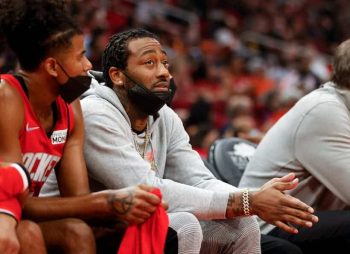NBA
NBA Sunday: Raptors Aren’t Extinct Just Yet

The Toronto Raptors aren’t extinct—not yet, anyway.
With the whirlwind of movement that dominates the headlines this past NBA offseason and the growth of several young players, we’ve spent far more time discussing the likes of the Boston Celtics, Detroit Pistons, Philadelphia 76ers and New York Knicks than the team from up North.
We’ve asked ourselves whether LeBron James and his Cleveland Cavaliers can win the Eastern Conference for a fourth consecutive year and whether or not the Washington Wizards are finally ready to give some credible resistance. Some of us have even gone as far as to predict that, in the ultimate irony, Kyrie Irving will lead the Celtics to the conference crown this season.
And that doesn’t even begin to talk about the storylines from out West.
All the while, quietly and meticulously, Dwane Casey and his Raptors have stalked, and you peer at the standings and realize that they enter play on November 19 at 10-5, tied with the Pistons for the second-best record in the conference.
What has made the Raptors thriving especially improbable is the fact that they’ve done it despite missing a few key contributors for a game or two. To this point, they have ranked respectably both in points allowed per game (102.6) and points allowed per 100 possessions (107.8). Those metrics rank them eighth and 11th, respectively.
So, where exactly do the Raptors fit in the grand scheme of things?
It seems like a question we’ve been asking for a few years now.
* * * * * *
Having qualified for the playoffs four consecutive years, Dwane Casey’s team has won three playoff series over the course of that duration, but haven’t exactly found timely and efficient play from their two star players in DeMar DeRozan and Kyle Lowry.
Now, as the Eastern Conference begins to feature younger players with appreciable upside—Joel Embiid, Kristaps Porzingis, Ben Simmons and Jaylen Brown to name a few—it’s totally fair to wonder where the Raptors fit in. It’s also fair, believe it or not, to wonder whether they’ll be able to provide as much resistance to the Cavaliers as the Celtics.
In effect, the Raptors have become a modern day version of Joe Johnson’s Atlanta Hawks. After signing with the Hawks prior to the 2005-06 season, Johnson led the revival of the franchise. They would end up qualifying for the playoffs five consecutive years, but never advanced past the second round. A similar story can be told of Chris Paul’s Los Angeles Clippers.
The point is, however, that over the years, the Raptors have developed an identity and are a team whose hallmarks have come to be toughness and ball-sharing—two characteristics that most coaches would love to embody their team. While we’ve been paying close attention to the things that are brand new and exciting, the Raptors are the same old crew that they have been. And for a team like that, the 2011 NBA Champion Dallas Mavericks will continue to be the gold standard.
The Mavericks notably rebuilt and tore down several incarnations of their team around Dirk Nowitzki until the team was finally able to surround Nowitzki with the right complement of players to score one of the biggest upsets in NBA Finals history.
Whether anyone chooses to acknowledge it, the Cavaliers are vulnerable.
Entering play on November 19, LeBron James leads the league in both total minutes played (617) and minutes played per game (38.6). Of the players who will comprise James’ supporting rotation in the playoffs, the majority of them are players whose impact will be mostly felt on one side of the floor: offense. To this point, the Cavs have 10 different players averaging 20 minutes played per game—an incredibly high number. More than anything else, that’s a result of Tyron Lue playing with his rotations to figure out which units work best, while also taking into account that the team has been playing without both Tristan Thompson and Derrick Rose for long stretches.
Still, of those rotation players—James, Rose, Thompson, J.R. Smith, Kevin Love, Jae Crowder, Dwyane Wade, Iman Shumpert, Kyle Korver and Jeff Green—the simple truth is that it is only James who has performed like a true two-way player.
It’s a troubling trend upon which the Raptors—and other teams in the conference—could capitalize.
The best two words to describe the Cavaliers to this point in the season are “old” and “slow,” and that’s simply a fact. The club still ranks dead last in points allowed per 100 possessions and 28th in the league in points allowed per game.
In short, the Cavaliers, at least to this point, have certainly appeared to be vulnerable. It is those same Cavaliers that have ended the Raptors season each of the past two years.
You know what they say about third times—they’re often the charm.
* * * * * *
There’s obviously a long way to go, and any chance that Toronto would have to get past the Cavs rests in the ability of Lowry and DeRozan to find some consistency in the playoffs. Still, as the complementary pieces around them have slowly improved, we have spent the early goings of the season fawning over the brand news teams and storylines in the conference and have paid no attention to the old guard.
And depending on how the brackets play out, any Cavaliers foray in the conference finals might have to go through the familiar road of Toronto.
If that happens to be the case—if the Cavs do have to square off against their familiar foe—they’re ripe for the picking.
Just as they have been over the past few years, the Duane Casey’s team will be there waiting for their opportunity.













